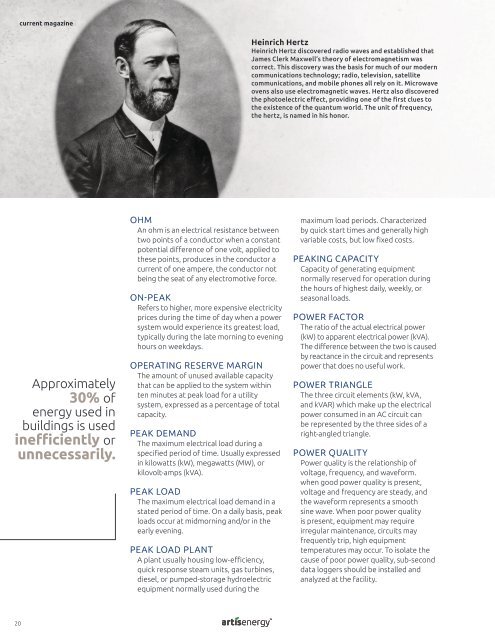Artis Energy Intelligence - Magazine Summer 2019
You also want an ePaper? Increase the reach of your titles
YUMPU automatically turns print PDFs into web optimized ePapers that Google loves.
current magazine<br />
Heinrich Hertz<br />
Heinrich Hertz discovered radio waves and established that<br />
James Clerk Maxwell’s theory of electromagnetism was<br />
correct. This discovery was the basis for much of our modern<br />
communications technology; radio, television, satellite<br />
communications, and mobile phones all rely on it. Microwave<br />
ovens also use electromagnetic waves. Hertz also discovered<br />
the photoelectric effect, providing one of the first clues to<br />
the existence of the quantum world. The unit of frequency,<br />
the hertz, is named in his honor.<br />
Approximately<br />
30% of<br />
energy used in<br />
buildings is used<br />
inefficiently or<br />
unnecessarily.<br />
OHM<br />
An ohm is an electrical resistance between<br />
two points of a conductor when a constant<br />
potential difference of one volt, applied to<br />
these points, produces in the conductor a<br />
current of one ampere, the conductor not<br />
being the seat of any electromotive force.<br />
ON-PEAK<br />
Refers to higher, more expensive electricity<br />
prices during the time of day when a power<br />
system would experience its greatest load,<br />
typically during the late morning to evening<br />
hours on weekdays.<br />
OPERATING RESERVE MARGIN<br />
The amount of unused available capacity<br />
that can be applied to the system within<br />
ten minutes at peak load for a utility<br />
system, expressed as a percentage of total<br />
capacity.<br />
PEAK DEMAND<br />
The maximum electrical load during a<br />
specified period of time. Usually expressed<br />
in kilowatts (kW), megawatts (MW), or<br />
kilovolt-amps (kVA).<br />
PEAK LOAD<br />
The maximum electrical load demand in a<br />
stated period of time. On a daily basis, peak<br />
loads occur at midmorning and/or in the<br />
early evening.<br />
PEAK LOAD PLANT<br />
A plant usually housing low-efficiency,<br />
quick response steam units, gas turbines,<br />
diesel, or pumped-storage hydroelectric<br />
equipment normally used during the<br />
maximum load periods. Characterized<br />
by quick start times and generally high<br />
variable costs, but low fixed costs.<br />
PEAKING CAPACITY<br />
Capacity of generating equipment<br />
normally reserved for operation during<br />
the hours of highest daily, weekly, or<br />
seasonal loads.<br />
POWER FACTOR<br />
The ratio of the actual electrical power<br />
(kW) to apparent electrical power (kVA).<br />
The difference between the two is caused<br />
by reactance in the circuit and represents<br />
power that does no useful work.<br />
POWER TRIANGLE<br />
The three circuit elements (kW, kVA,<br />
and kVAR) which make up the electrical<br />
power consumed in an AC circuit can<br />
be represented by the three sides of a<br />
right-angled triangle.<br />
POWER QUALITY<br />
Power quality is the relationship of<br />
voltage, frequency, and waveform.<br />
when good power quality is present,<br />
voltage and frequency are steady, and<br />
the waveform represents a smooth<br />
sine wave. When poor power quality<br />
is present, equipment may require<br />
irregular maintenance, circuits may<br />
frequently trip, high equipment<br />
temperatures may occur. To isolate the<br />
cause of poor power quality, sub-second<br />
data loggers should be installed and<br />
analyzed at the facility.<br />
20


